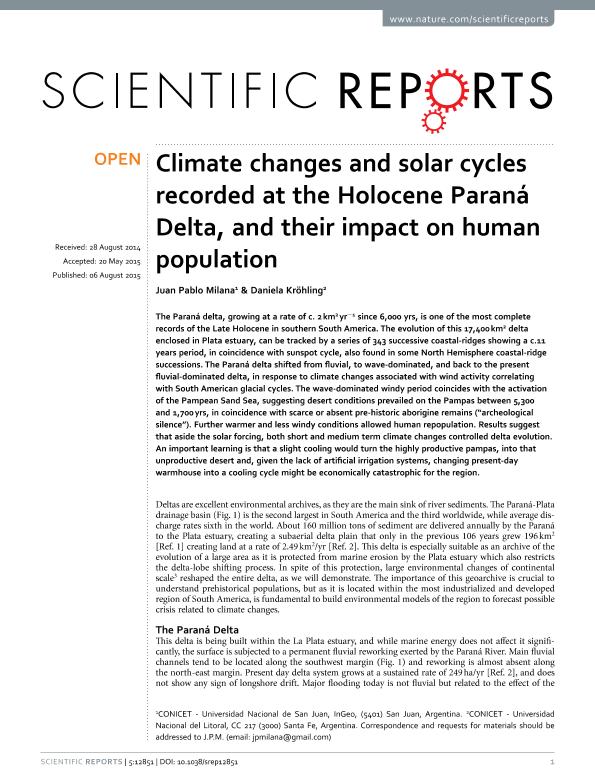Artículo
Climate changes and solar cycles recorded at the Holocene Paraná Delta, and their impact on human population
Fecha de publicación:
08/2015
Editorial:
Macmillan Publishers Limited
Revista:
Scientific Reports
e-ISSN:
2045-2322
Idioma:
Inglés
Tipo de recurso:
Artículo publicado
Clasificación temática:
Resumen
The Paraná delta, growing at a rate of c. 2 km2 yr-1 since 6,000 yrs, is one of the most complete record of late Holocene in southern South America. The evolution of this 17,400 km2 delta enclosed in Plata estuary, can be tracked by a series of 343 successive coastal-ridge showing a c.11 years period, in coincidence with sunspot cycle, also found in some North Hemisphere coastal-ridge successions. The Paraná delta shifted from fluvial, to wave-dominated, and back to the present fluvial dominated delta, in response to climate changes associated with wind activity correlating with South American glacial cycles. The wave-dominated windy period coincides with activation of the Pampean Sand Sea, suggesting desert conditions prevailed on the Pampas between 5,300 and 1,700 yrs, in coincidence with scarce or absent pre-historic aborigine remains (?archeological silence?). Further warmer and less windy conditions allowed human repopulation. Results suggest that aside the solar forcing, both short and medium term climate changes controlled delta evolution. An important learning is that a slight cooling would turn the highly productive pampas, into that unproductive desert and, given the lack of artificial irrigation systems, changing present-day warmhouse into a cooling cycle might be economically catastrophic for the region.
Palabras clave:
Holocene
,
Parana River Delta
,
South America
,
Climatic Changes
Archivos asociados
Licencia
Identificadores
Colecciones
Articulos(CCT - SANTA FE)
Articulos de CTRO.CIENTIFICO TECNOL.CONICET - SANTA FE
Articulos de CTRO.CIENTIFICO TECNOL.CONICET - SANTA FE
Citación
Milana, Juan Pablo; Krohling, Daniela Mariel Ines; Climate changes and solar cycles recorded at the Holocene Paraná Delta, and their impact on human population; Macmillan Publishers Limited; Scientific Reports; 5; E12851; 8-2015; 1-8
Compartir
Altmétricas




